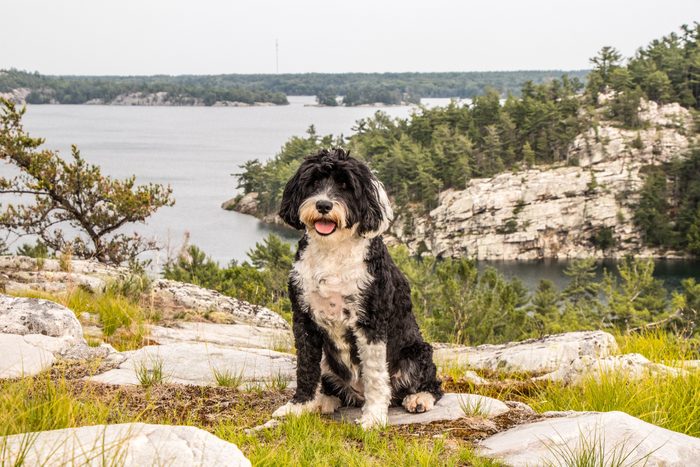
Do dogs that don’t shed actually exist?
Hair of the dog—it can be lovely to look at and soft to caress—but nobody likes hair in the air, clogging the vacuum, on their clothes, in their food or up their nose. Is there really such a thing as a dog that doesn’t shed? And are low-shedders really hypoallergenic?
To find out, we asked two experts, Esmeralda Krop, Esmeralda Krop, PhD, an immunologist at Utrecht University in the Netherlands and Jennifer Bishop-Jenkins, a National Certified Master-Groomer.
Are some dog breeds hypoallergenic?
Like us, you’ve probably read claim after claim that this breed or that is hypoallergenic. However, Krop shares, that in her research, “We found no hypoallergenic dog breeds.”
Moreover, it turns out it doesn’t matter how much a dog sheds when it comes to producing allergens, substances that can cause an allergic reaction. “Allergens are very small molecules, that easily become airborne and reach the eyes, nose and lungs, where they cause symptoms. Dog hairs are too large to be allergens.” Krop explains. So, where do dog allergens come from? Their sweat and saliva. “Both can be present on hairs of dogs [from exercise or self-cleaning], but a dog’s shedding level does not affect its allergenicity,” she says.
What about so-called hypoallergenic breeds, such as poodles and doodles? “In our study, we found that allergenicity was not a breed characteristic,” says Krop. “We tested for the allergen Can f1 (one of many dog allergens) and in each breed, we found dogs with high levels and dogs with low levels. And as there are many dog allergens, it’s also possible that a dog that sheds little Can f1 can shed more of other allergens.”
Do some dog breeds shed less than others?
Yes, there are non-shedding dogs that shed less than their furry counterparts. But to understand why, you have to understand some of the science of hair growth. Bishop-Jenkins explains that there are two types of dog coats: those that grow to a predetermined length (PDL) and those that grow to an undetermined length (UDL).
“PDL hairs, aka ‘fur’ in dogs, grow to a specific length and stop—similar to your eyebrows,” she explains. These dogs—boxers, Australian shepherds, collies, Newfoundlands and such—don’t get clipped, but shed a little all the time plus heavily as the seasons change, she says.
“In contrast, UDL hairs grow and grow until they are cut or they break, like the hair on your head,” Bishop-Jenkinis says. These breeds, including poodles, Shih Tzu, Yorkies, old English sheepdogs, doodles and more shed less. However, “the trade-off to less shedding is more matting, tangling and the need for regular grooming,” says Bishop-Jenkins.
Read on to meet some of the dog breeds that don’t shed as much.
About the experts
|
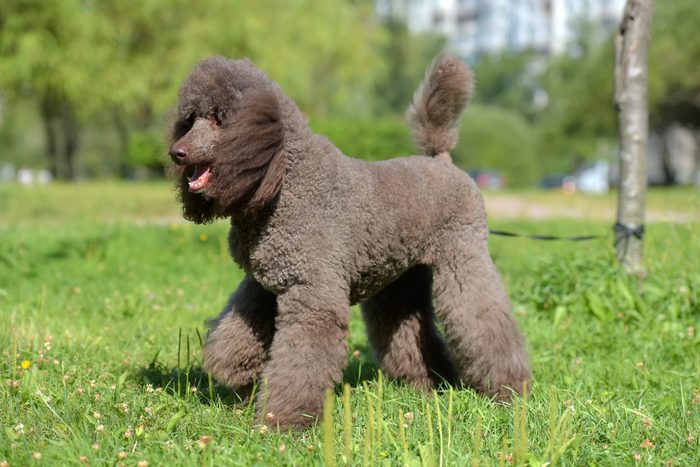
Poodle
If you love both dogs and topiary, the poodle is your dream dog that doesn’t shed. The poster dog of sculpted hair-dos, the poodle has a curly coat that grows and grows and grows. In the 1800s, poodles were shown with cords dragging the ground, but today the coifs are a little shorter. They won’t shed, but they need professional clipping every six weeks. If they’re not combed out they can mat into a solid rug of fur. The great thing about poodles, besides their super-smarts, is that they come in three official sizes: Toy, Miniature and Standard.
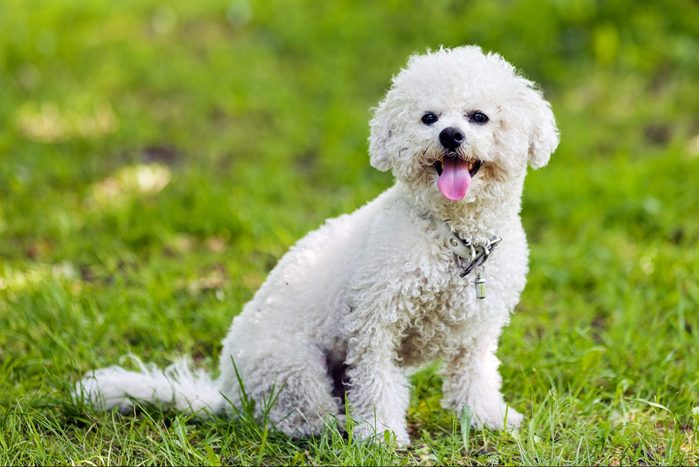
Bichon Frisé
If you’ve dreamed of a dog that looks just like a giant cotton ball, the Bichon is your dog. The Bichon’s poofy coat is long, soft and curly, so it looks like a fluffy white cloud—or a cotton ball. It’s one of several breeds that are always white. It takes regular combing to make sure the coat doesn’t mat, so most people elect to have their Bichon professionally groomed every month or two, so it’s more like a cotton swab than a ball. Bichons are smart and happy and love to perform tricks, but one trick some have a problem with is housebreaking.
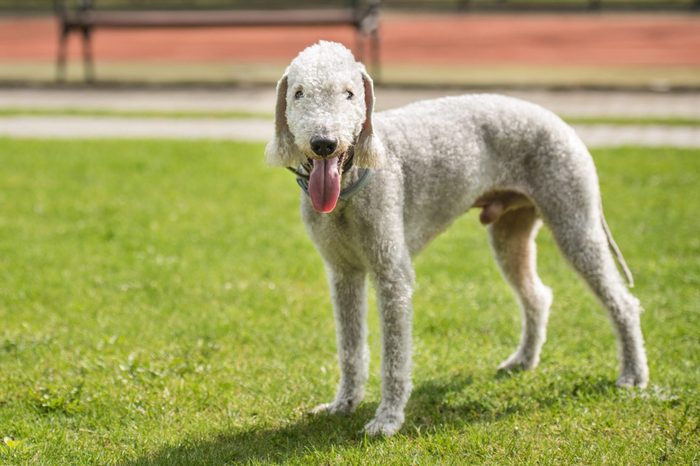
Bedlington terrier
Want your neighbors to talk about you? Try walking your pet lamb around the block. At least, that’s what they’ll think if you keep your Bedlington in its show groom. It’s covered with long plush curly hair and traditionally scissored all over to look like a little sheep—and to feel amazingly poofy. It really does feel like putting your hands into a pillow filled with down. You do have to comb it diligently to keep mats away, and scissoring is an art form, so you may prefer to have a professional groomer clip its coat short. They come in two colors: gray or light liver. Don’t be fooled by that lambie pie sweet face; while gentle to people, they are ferocious ratters who aren’t afraid to get down and dirty in pursuit of prey.
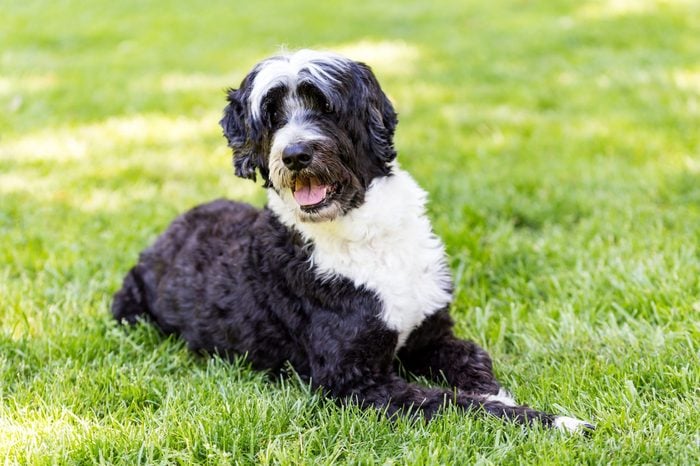
Portuguese water dog
You might think this is a Poodle with another weird hairdo or even a doodle, but the Porty is an entirely separate breed, stockier and sort of like a more manly-man’s Poodle. They were bred to help fisherman with their nets and other wet jobs. They can have long curly poodle-ish hair or they can have long wavy hair and both coat types need regular grooming. They’re traditionally clipped so the front half is long and the back half is shaved short. These are super smart dogs that love to swim and retrieve, so a short haircut all over may be easier to keep dry and tangle-free. If they look familiar, it’s probably because one lived in the White House with the Obamas.
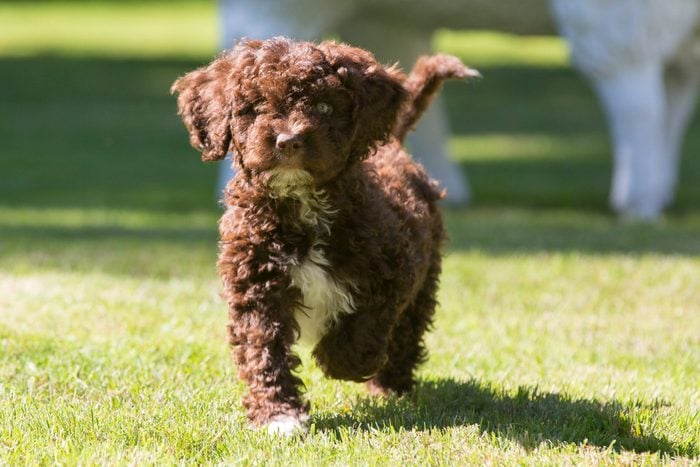
Spanish water dog
This ancient breed was a jack of all trades in Spain, serving as a herding dogs, guardian and fisherman’s helper. These days they are used as search and rescue dogs, and drug detection dogs, among countless other tasks. They’ve even been trained as circus dogs. They were traditionally sheared once a year then allowed to grow out all year, and many people still follow that tradition. The coat tends to curl and to form cords. This breed is one of those undiscovered gems of the dog world, with a great personality, handy size and non-shedding coat.
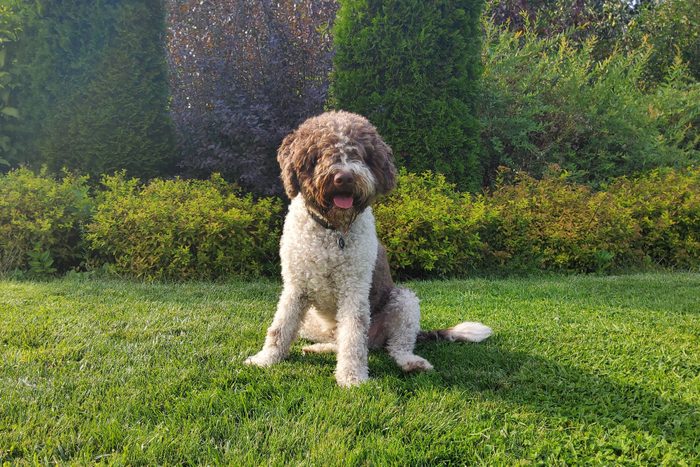
Lagotto Romagnolo
While your neighbors might assume your new dog is a doodle-mix, the Lagotto is an ancient breed developed in Italy to sniff out these fungal delicacies in the wild. Of course, the hardest part of owning one is pronouncing the name: Low-got-tow Ro-man-yow-low. They’re covered with wooly curls from head to toe, giving them a teddy bear appearance. Lagottos started life as retrievers back in the Renaissance, and they still love to swim and fetch. And this bouncy bundle of curls will fetch your heart in no time if you give it a chance.
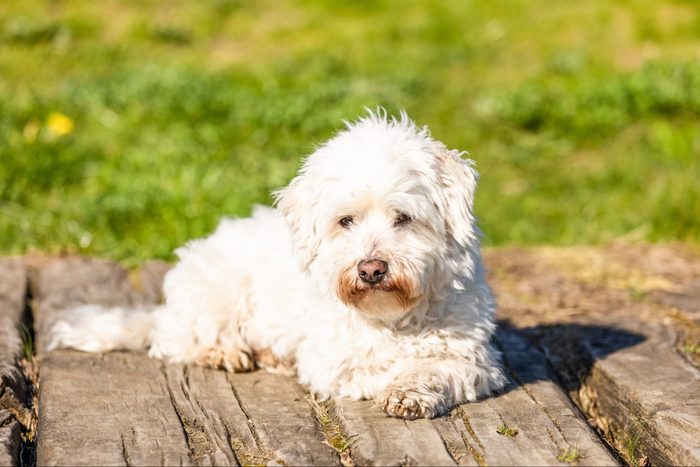
Coton de Tulear
Its name means cotton of Tulear, and their fluffy coats really are like cotton. Allowed to grow out, it billows around the dog like soft clouds. Like cotton, it’s always white. The downside is that long, cottony coats like to mat, so this dog breed that doesn’t shed is best for people who love to sit on the sofa and groom their dog to keep it free of grass and sticks—or have the coat professionally trimmed to a cuter more manageable length. The always white Coton is friendly, affectionate and fun-loving, a perfect apartment dog or companion for the elderly, as well as considerate children.
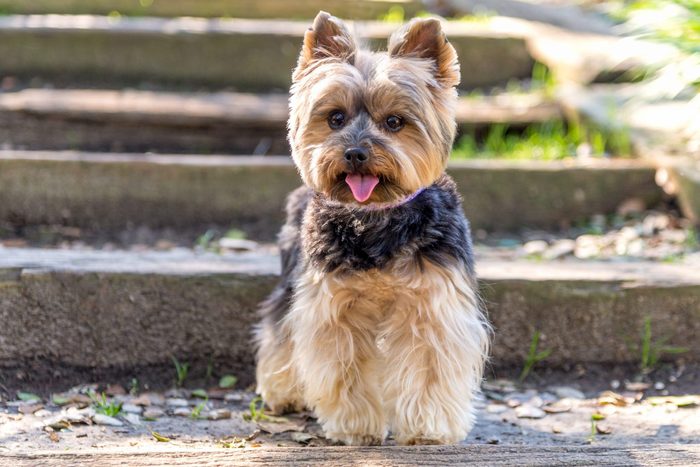
Yorkshire terrier
The Yorkie has long straight silky hair that’s a combination of gunmetal blue with rust color. If you take good care of it, the coat can drag the ground. If you’re more practical you’ll have it professionally clipped every six weeks or so into a pixie look—which really fits this breed’s loving but mischievous personality better anyway. Yorkies don’t mind chasing a mouse when it has a chance, they are terriers after all. That’s also why they can be feisty and fun. Check out the Silky terrier for a similar breed with a bit shorter coat, or the Biewer terrier for a similar breed with a multi-colored coat.
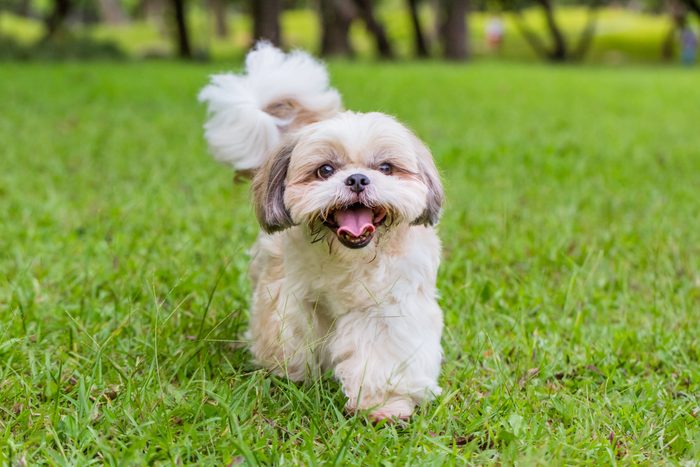
Shih Tzu
The Shih Tzu is a perennial favorite when it comes to ideal companion dogs. They’re small and smart, lively and loving—and their hair doesn’t shed much. If you let the coat grow out, and take good care of it, it will trail the ground. But for a more practical lifestyle, most people prefer to have it trimmed, giving the dog a cute stuffed animal appearance. They make great apartment dogs and love to go shopping or to restaurants. They are gentle and great with kids, too. For a similar-looking but just slightly larger low-shedding breed, consider the Lhasa Apso.
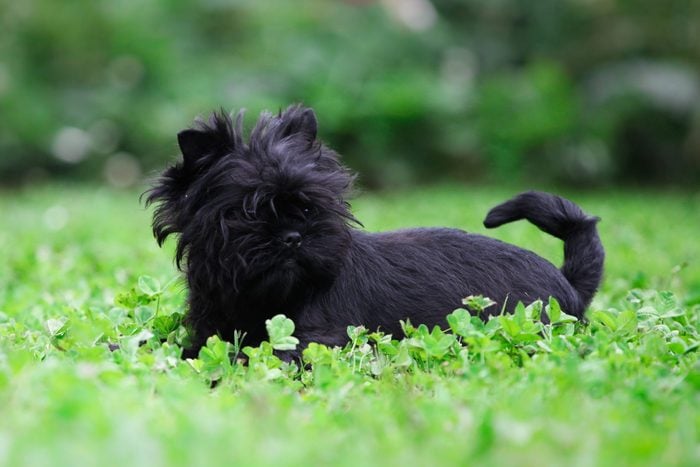
Affenpinscher
This little gremlin is a toy-sized terrier that has all the spunk and spirit of the big guys, shrunk down into a smaller body. Their wiry coat is medium length and always manages to look disheveled—probably because their mischievous personality has it mussing its hair like a whirling dervish. For other small wiry breeds consider the Brussels griffon or miniature wirehaired dachshund.
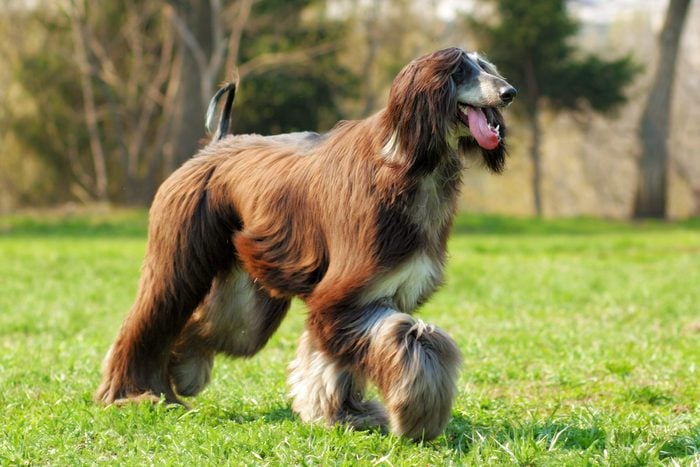
Afghan hound
The king of dogs wears a robe of spun silk. Upkeep is not for the lazy, but with regular brushing and combing, the long straight coat can reach almost to the ground. The Afghan hound is part courtesan, part court jester, so be ready to be entertained! Just don’t expect to be obeyed—the Afghan hound is a free spirit. But you may forgive him because he’s so beautiful as he gallops across the field, coat flowing, one of the fastest breeds. If you like the general look (and another of the fastest breeds) but not quite as much hair (but probably a bit more shedding) there’s the saluki, which looks like an Afghan hound but with long hair only on its ears, tail and feet.
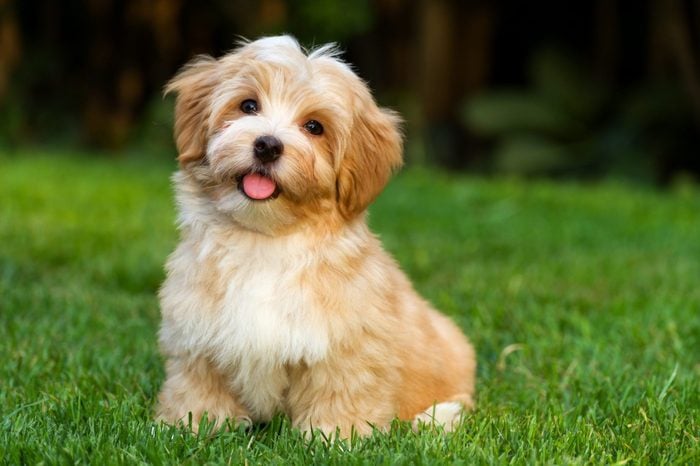
Havanese
This Cuban cutey has a long fluffy coat that’s always slightly disheveled (on purpose), adding to its impish charm. It has a slightly coarser texture and just the slightest bit of frizz that gives it extra body, but that body also makes it both less likely to shed hair and more likely to tangle. The Havanese coat can also be corded; that is, trained to gather together in long mop-like tresses. For a larger whiter version check out the Coton de Tulear, but its coat takes way more work. The Havanese is a happy-go-lucky toy dog with a jaunty gait that is one of the fastest gaining most popular breeds.
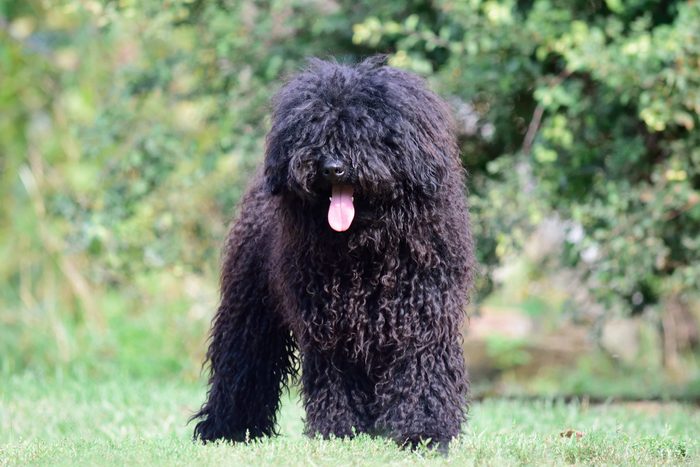
Puli
The Puli can come in black or white, and looks like a Disney cartoon mop that has come to life. They have a corded coat in which the hairs wrap around each other to form long cords, or yarn-like strings of hair. Cording takes a lot of work to get right, and a lot of time to bathe, but corded dogs don’t shed a bit since all their hair is tied up. Other corded breeds include the Komondor and Bergamasco sheepdog—even the Poodle and Havanese can be corded.
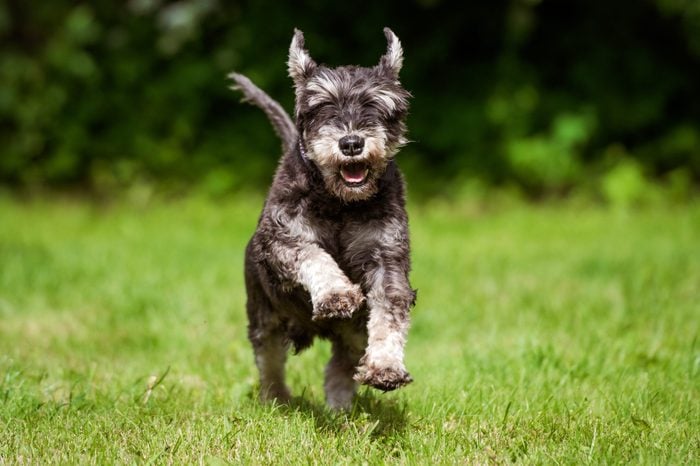
Schnauzer
Not all dogs with non-shed coats are silky or curly. The Schnauzer is one of several breeds with medium-length wiry coats. The schnauzer’s hair is typically professionally groomed so that it’s short on the back and part of the way down the sides, but long on the legs. The face has long eyebrows and a beard, giving them a rakish look. Schnauzers come in three sizes: miniature, which is the size you see most often; standard, which is a little bigger; and giant, which is a lot bigger, think Doberman-sized. The hair of any size needs to be combed out at least weekly, but it doesn’t mat as easily as dogs with softer coats.
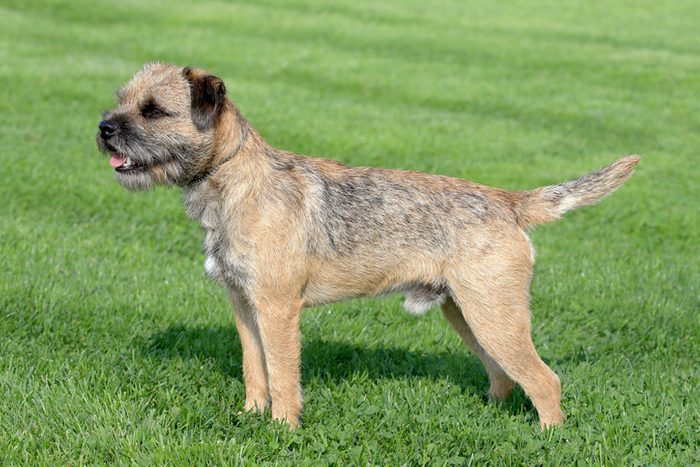
Border terrier
Terriers have a reputation for being active and feisty, but the border terrier is known as the mellow fellow of the terrier group. Created to run with the hounds on foxhunts, they had to get along with other dogs—but they were still tough enough to get the fox at the end. Their coat is medium length, straight and wiry. If you let it grow out the dog will look kind of like a tumbleweed, but at least they won’t shed or mat. The longer hairs eventually die but you have to pull them out by hand, a process called plucking or stripping. Clipping them ruins the texture, but you can have a groomer do that, too.
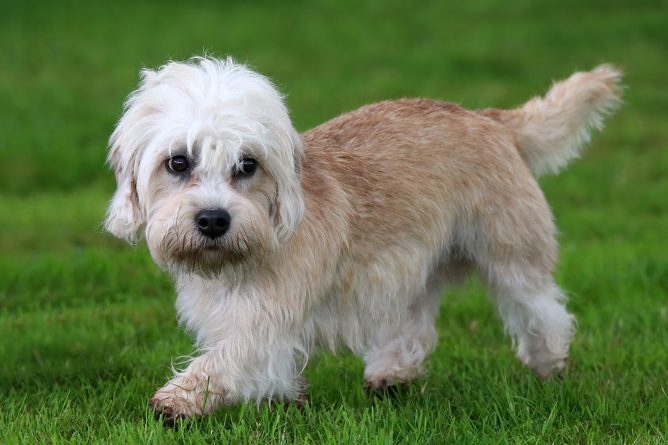
Dandy Dinmont terrier
The Dandy is the only breed of dog named for a character in a book, in this case, the book Guy Mannering. With its big dandelion head, sad eyes, long curvy back and short legs, it looks like a cartoon character. Its coat is traditionally groomed to be poofy on the head and stripped short on the body, with the sides and legs longer. The Dandy Dinmont is so rare it’s in danger of becoming an extinct breed, so if you add one of these to your family you’ll do your part to save a breed!
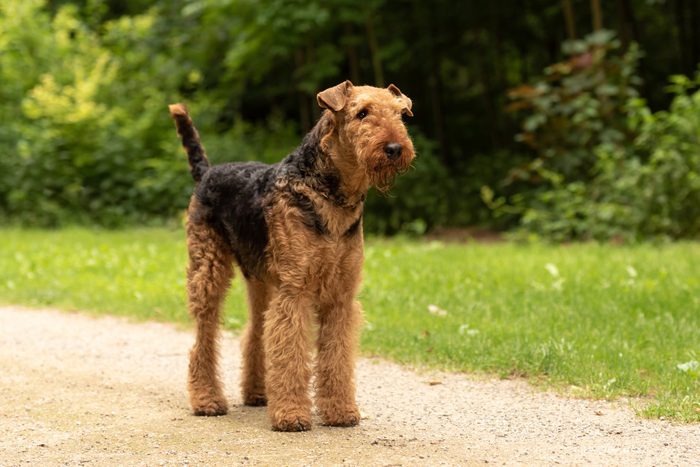
Airedale terrier
The largest terrier breed, the Airedale was once used as a police dog. It used to be a very popular breed, but as people favored the smaller terriers it became less so. Its coat is long, wiry and wavy. Most Airedales are professionally groomed every month or two. The coat on the back is ideally plucked or stripped out, so only the longer dead hairs are removed. But it’s easier to just clip it short, even though that does away with the correct harsh texture. The hair on the legs is scissored and brushed out to have a stove-pipe appearance, and the head has a beard and brows, for that serious, studious look. Don’t let that serious look fool you, though; Airedales can be clowns! Smaller terriers with a similar look include the Welsh terrier, Lakeland terrier and Irish terrier.
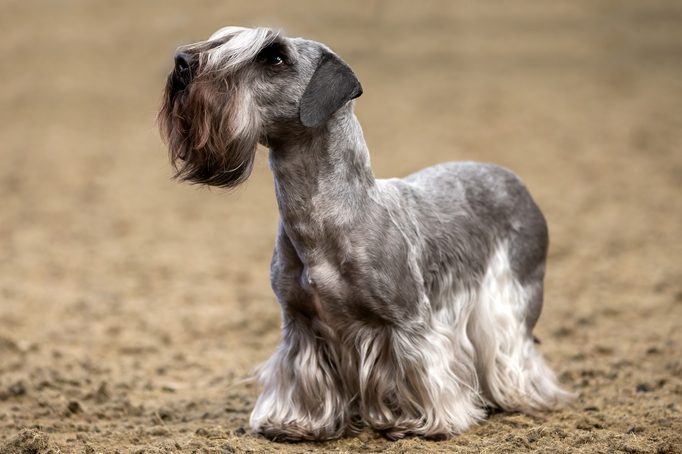
Cesky terrier
Here’s one you never heard of: the Cesky (say CHESS-key) terrier was developed in the mid-1900s to produce a Scottish-terrier-like dog that got along better with other terriers so it could hunt in packs, and that had an easier coat to care for. They’ve been in the AKC Terrier group only since 2011, and still remain obscure. But they shouldn’t be: they are fun-loving, mellow and non-aggressive. Unlike most terriers with a harsh coat, their coat is supposed to be clipped, not hand-stripped, every six weeks. And it’s a mostly non-shedding dog breed. This is another rare breed that needs more people—you can do your part to help it survive.
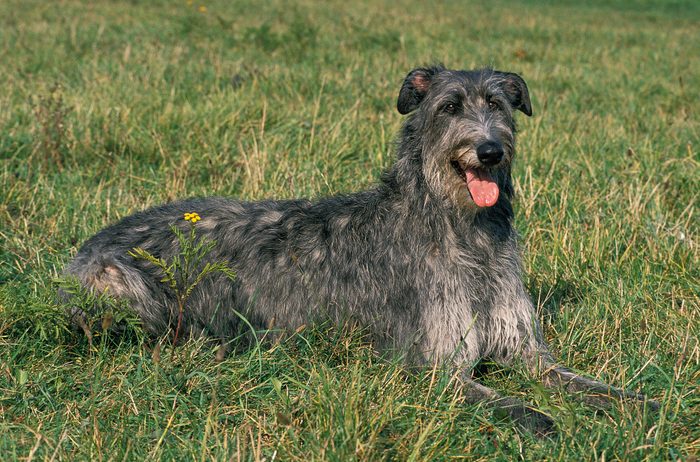
Scottish deerhound
The Scottish deerhound fits the bill of a really big dog that doesn’t shed that much; their coat is medium to long and wiry. It doesn’t need any fancy grooming but will look tidier if you pluck out the dead hairs as needed and comb it occasionally. The Deerhound is super laid back and one of the most regal of breeds. Like most sighthounds, they’re not into following commands and like to give chase, but they’re no trouble-makers. Want an even bigger version with the same coat? Check out the Irish wolfhound.
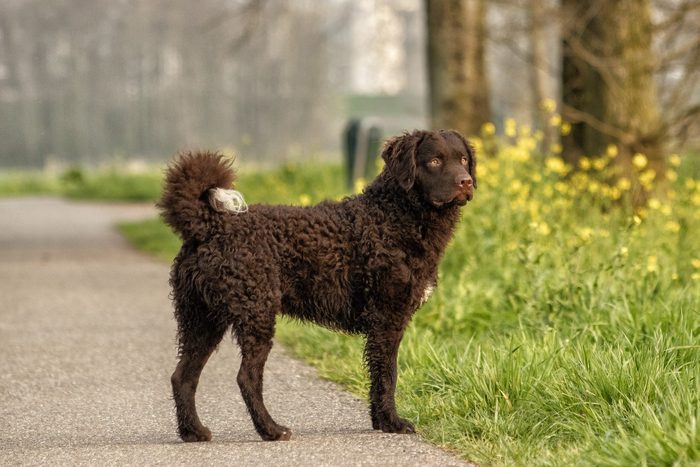
Curly-coated retriever
Those curls! With one of the most tightly curled coats of all breeds, the curly looks like it just stepped out of the beauty salon with a new perm. But it’s all-natural, and the short to medium-length coat really takes little grooming at all. Best of all, the curly comes with that great retriever personality, ready to swim, retrieve, play and always eager to learn new things. If you like other really curly breeds, also check the Irish water spaniel and American water spaniel.
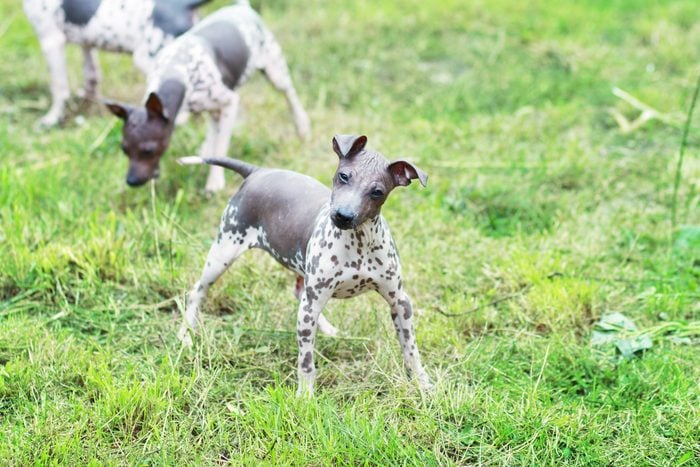
American hairless terrier
These smooth operators take sleek and svelte to a whole other level, American hairless terriers don’t have any hair at all except for their whiskers. Unlike other hairless breeds, the gene responsible for their hair-challenged bodies doesn’t leave a mane and tail or affect the teeth, so they are actually true-breeding and truly hairless. They resemble their rat terrier ancestors, so are full of vim and vigor. This is a hardy breed (well, they still need a coat in cold weather) that’s pretty rough and tumble and great for kids.
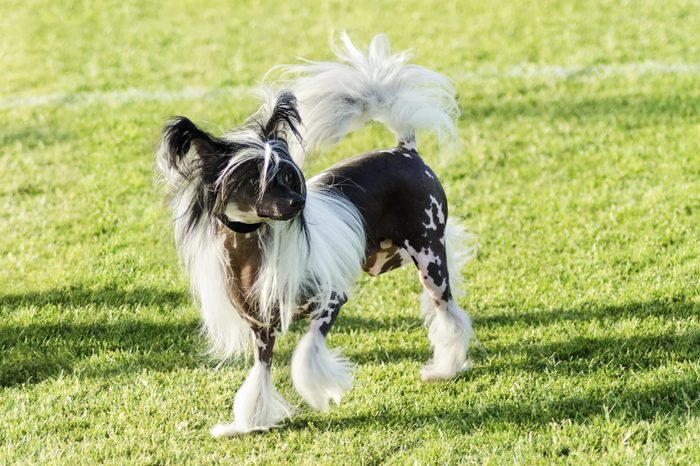
Chinese crested dog
With their flowing mane and tail, the Crested looks like a tiny pony prancing around the house. It comes in two coat types: the hairless, which has bare skin on its body but long hair on the top of its head, ankles and tail; and the powderpuff, which has long hair all over. Obviously, the hairless doesn’t have much hair to shed, but even the powderpuff sheds very little. Cresteds are agile and smart and they excel at agility and doing tricks—and love to cuddle. Understand that though hairless breeds don’t require much brushing, they do require extra skin care.
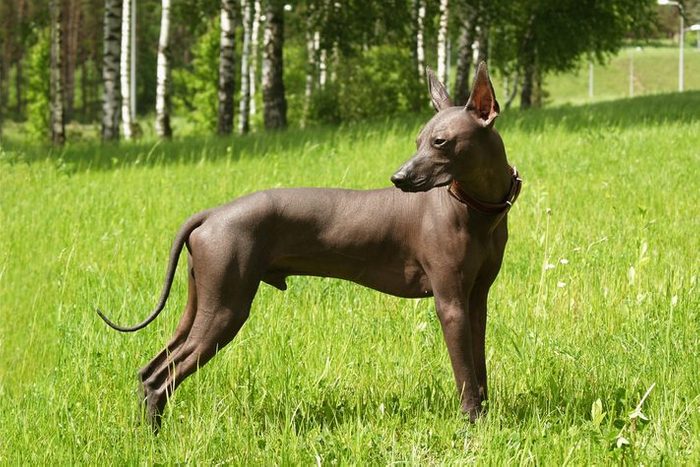
Xoloitzcuintli
Big, bald and beautiful! That’s the Xoloitzcuitli (Xolo for short), another hairless dog breed. With their well-defined muscles and sleek physique, they look like living onyx statues. But remember, just because they’re hairless doesn’t mean they’re care-less. The skin needs to be kept clean, moisturized, checked for acne or blackheads and protected from sunburn. But they won’t shed! They do actually have very short hard hair on the top of their hair, feet and tail tip, but it’s so short good luck finding a single hair in your house. They come in three sizes, from very small to pretty big, and there’s also a coated version, with normal short hair all over—that sheds. For a similar, but more slender (and even rarer) hairless breed, check out the Peruvian Inca Orchid.
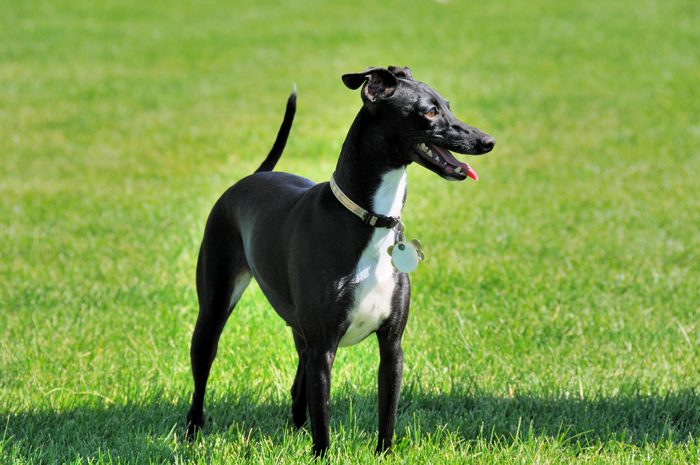
Italian greyhound
True, the I.G. (Iggy to friends) doesn’t really belong here because their short coats do indeed shed. But the toy-sized but leggy Iggy has super short hair and a small body so at least what gets shed is still not a lot. That super short coat also doesn’t give the Iggy much warmth, so this breed needs to wear a sweater in cool weather. They like to sunbathe, and unlike with the hairless breeds, you don’t have to worry about caring for their bald skin. Italian greyhounds make super elegant loving dogs that do well in apartments and make great bed buddies for the elderly.
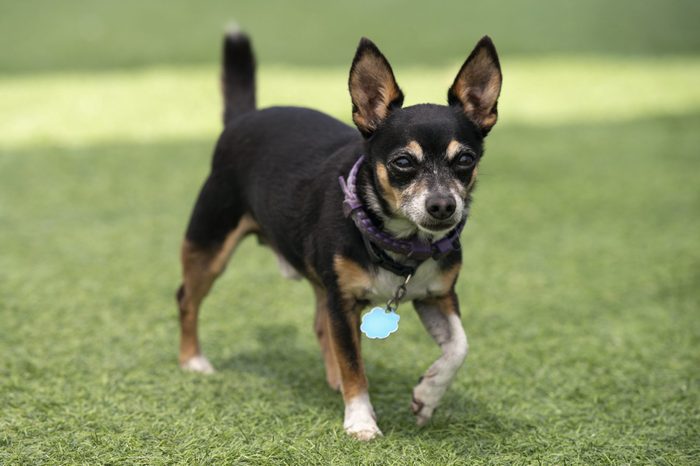
Miniature pinscher
The MinPin gets in here for the same reason the Italian greyhound does: their coats, while of the shedding type, are super short and there’s just not that much body surface on their toy-sized bodies to have a lot of it. The MinPin is dogdom’s answer to the perpetual motion machine. It does well in apartments but be prepared to have a dog in constant motion. They’re very active and playful but can bark a lot. The MinPin is a tough character, totally unaware that it doesn’t weigh 80 pounds. But they’re gentle to their people and very sweet, loving and playful.
Why trust us
At Reader’s Digest, we’re committed to producing high-quality content by writers with expertise and experience in their field in consultation with relevant, qualified experts. For this piece, Caroline Coile, PhD, tapped her experience as an award-winning journalist specializing in canine breeds, health and science. We verify all facts and data, back them with credible sourcing and revisit them over time to ensure they remain accurate and up to date. Read more about our team, our contributors and our editorial policies.
Sources:
- Esmeralda Krop, PhD, immunologist at Utrecht University in the Netherlands; email interview on March 14, 2024
- Jennifer Bishop-Jenkins, certified Master Groomer; email interview on March 13, 2024
- Journal of Allergy and Clinical Immunology: “Can f1 levels in hair and homes of different dog breeds: Lack of evidence to describe any dog breed as hypoallergenic”
